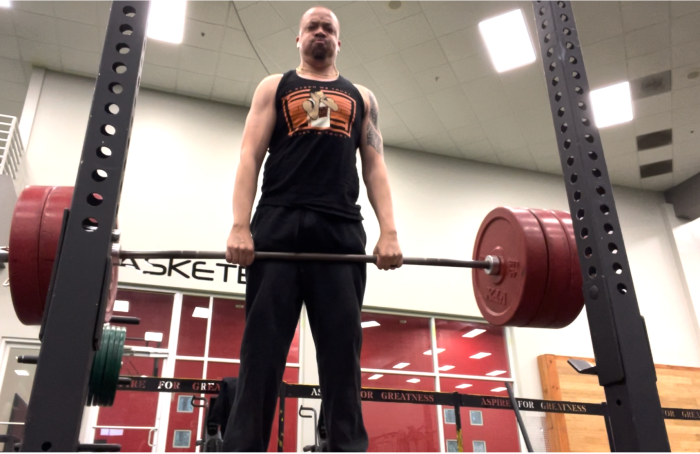I bent over and put my hands on the barbell. I looked to my right. Four red 45-pound plates on one end. I looked to my left and counted the same. With the 45-pound bar, it added up to a total of 405 pounds.
It’d been my goal for a few years to deadlift 400 pounds. I’d been feeling good about my ability to get that amount of weight up. I pulled the slack out of the barbell, feeling the light tug of the weights. I locked my body into place. I got the weight up to my knees, my back still bent, my grip loosening as the weights slipped to my fingertips. Then I felt my body give way and my back tighten, a pull that signaled an impending injury if I kept struggling to get the weight up.
I wasn’t going to make it. So I bailed on the lift, dropping the weights. I hung my head for a second while the sound of the plates bouncing up and down on the ground played like a soundtrack to my failure. I was disappointed I couldn’t hit my goal, but that disappointment gave way to something better. I felt proud of myself: I understood my body and my limitations and didn’t push it too far. It was this understanding that I’d been longing for and have finally been able to find thanks in large part to deadlifting.
Because I’ve never liked my body.
That’s too kind.
I’ve spent most of my life despising my body.
The world, wide openRead now
Loathing it to the point that I’ve distanced myself from it as much as one can remove oneself from the flesh that holds their insides in place. I started gaining weight when I was about 8 years old. I don’t know why or how, exactly. I weighed 100 pounds in third grade. I remember this because they’d weigh us in class in front of everyone. I don’t remember why. I do remember my best friend laughing at me.
As I got older, I kept getting bigger. In middle and high school, I took medication for migraines that caused my weight to skyrocket. In 10th grade, I was 5-feet-10 and 260 pounds. I was also developing stretch marks. They were bright red and reached from the top of my shoulders to the back of my knees. Deep, red craters that looked, and felt, like scars.
Back then, I’d hide my body under baggy clothes, bad posture and a windbreaker I wore no matter how much the Mississippi heat made me sweat through my shirts. When I took showers I’d turn my back to the mirror, and I’d look up when I bathed so I wouldn’t have to bear witness to my body.
By my senior year in high school, I’d stop the medication. I’d eat less. I’d play basketball more. I lost weight. A full 100 pounds. But it didn’t matter. I didn’t see the scrawny kid I’d become. I still saw the fat kid who would sweat down the back of his neck. I still wore the same size clothes I did when I was fat. I still never took my shirt off. I still got nervous when women touched my body.
I’d spend my 20s and 30s with my weight in flux. Depression in grad school had me skinny. Being a new dad and living off of po’boys in New Orleans made me fat again. About five years ago, I cut out the four or five sodas I was drinking a day, started intermittent fasting and shrunk into a body that felt sustainable. An appropriately proportioned “dad bod” of tight parts, loose parts, sinewy shoulders, stubborn chest fat and those stretch marks. A body I wanted to separate myself from when I was 260 pounds and when I was 160 pounds. But a body I knew I’d have to live with.
I was fat the first time I deadlifted. It was maybe 2017 or so. I was going to an LA Fitness by my office every day at lunchtime, mostly to play basketball. I should note that I’ve always been relatively athletic, no matter how much I weighed. I could run — OK, jog — up and down the court for three or four games with no problem. And the gym had always been part of my regimen.
But one day, I decided to try a deadlift. I didn’t know anything about them. I’d just watched a guy do them, and gave it a try. What could go wrong? In short: a lot.
The conventional deadlift is a full body exercise that is a complete test of a lifter’s raw strength. The lifter puts their feet about shoulder width apart with their hands outside of their legs, grabbing the barbell. The deadlift is one of the most comprehensive and complex exercises one can pull off at the gym. While its benefits are many — activated core, muscle building and strength training — it’s difficult to execute correctly as it requires proper form so as not to cause back injuries. Doing it right requires a conscious understanding and carefulness with the body.
The day I decided to give it a try, I put 45-pound plates on each side of the barbell. I bent over like I was tying my shoes, my back rounded at the top, my knees barely bent. My head pointed to the ground. I looked like Bambi on ice. I lifted the weight and immediately felt like someone had implanted firecrackers in my spine. Each pop sounded off in my body with every inch I lifted.
I could barely walk for a week.
 David deadlifting at the gym.
David deadlifting at the gym.
David Dennis Jr.
I stayed away from deadlifting for years. There was no point in jacking up my back like that. But when I started losing weight again, I went down a YouTube rabbit hole on the benefits of deadlifting.
The more I watched, the more I wanted to conquer these movements. Just the idea of pulling massive amounts of weight off the ground made me feel like a WWE star. And the thought of adding weight, getting stronger and setting goals seemed like a fun challenge. So the first thing I did when I joined a new gym was get a trainer to show me how to do a deadlift.
He explained to me that you have to imagine a rope pulling your hips, causing the top half of your body to lean toward the barbell. He showed me how to flatten my back and protect myself. But I still didn’t really listen. For two years I’d max out at 225 and always feel this pain in my lower back. It wasn’t debilitating like the first time, but persistent. It would nag at me for a couple of days, a reminder that I still didn’t know what I was doing.
Still, I figured I could power through it and reach a goal I’d set for myself: deadlifting 400 pounds. But when the pandemic hit, that goal was deferred.
Like everyone else, I spent most of 2020 stuck in the house. The pandemic was hell for people like me who didn’t know how to assess their bodies. I didn’t go to the gym, and I spent thousands of dollars on home workout equipment that didn’t work for me. I ate pizzas multiple times a week. I gained weight. My body again reverted back into its hiding place under sweatshirts and loose sweatpants. I tried to look at myself in the mirror but couldn’t tell how I looked. I couldn’t tell if I was skinny, lean, muscular or fat again. I’d weigh myself but it didn’t matter. If the weight went down or climbed up I still had no clue what kind of body I was living in. Sometimes an old shirt would feel tighter, and I’d ask myself: Did I put it in the dryer by accident? If my sweatpants felt looser, I’d wonder: Am I getting smaller? Am I losing muscle? My mind was a Rubik’s cube of jumbled thoughts and I couldn’t line up the blocks to formulate a picture where all the colors matched.
 Atlanta rapper Jeezy talks 60-pound weight loss journey and the July Fourth AJC Peachtree Road RaceRead now
Atlanta rapper Jeezy talks 60-pound weight loss journey and the July Fourth AJC Peachtree Road RaceRead now
I returned to the gym after getting my first COVID-19 vaccine dose in March 2021, a little plumper, a lot more insecure and scared to do deadlifts. It’d been so long and my sedentary bones had settled into rigid, inflexible things that creaked a little more than usual. It had been a year since I’d attempted a deadlift and the exercise seemed like a thing of the past.
But it kept calling me. The fact that 400 pounds still eluded me meant I had to try again.
My fear of doing real damage to my back caused me to be more cautious than I’d ever been. And to be careful with a deadlift means taking inventory of your body to see what I did wrong pre-pandemic.
See, the deadlift form is kind of like a golf swing. There’s probably one best way to do it, but everyone has their own way to tweak it, because everyone’s body is different. So for me to find the posture and form that didn’t hurt, I had to do something I’d never done before: listen to my body.
I started with my toes, making sure the bar was right over them. I made sure my shins were right up on the barbell. My knees bent but not too much so as to not put all the torque on those sensitive joints. My hips were back as if a magnet were pulling my butt toward the wall behind me. My back was straight. My arms hung down, making sure my shoulders were even with the barbell. Something interesting happened while I was having this silent conversation with my body: I felt comfort. I didn’t feel the bend of my back or the strain on my spine. I felt at ease with myself and the pain was gone.
 Motivation Monday: These 17-year-olds set a goal and reached itRead now
Motivation Monday: These 17-year-olds set a goal and reached itRead now
I pulled the barbell up lifting ever so slightly so the weights were barely touching the ground, removing the slack, locking my muscles in place and creating a safer, more activated motion. And in that split second I continued to ask myself the important questions, letting my brain fall into my body and make sure everything felt good. Do any muscles ache? Does anything feel off from my head to my toes? I push my feet against the ground and lift. The pulling motion sends electricity through my hips, my upper back, my core, my arms, my entire body. The feeling invigorates me.
I do this four times a week. About 15 reps of various weights per session. And with each rep I have this same discussion with my body. A questionnaire. A chance to get to know this stranger who’s been with me my whole life. A way to feel how this thing I wanted no part of has been changing, getting stronger, aching and needing me to recognize it so I can treat it how it deserves to be treated, for being good to me even when I wasn’t good to it. Doing these deadlifts and trying to stay healthy has forced me to get to know my body and, somewhere along the way, I started loving it. I started looking at it, taking in its imperfections and beautiful parts. Enjoying the feel of clothes against my skin, and the knowledge that no matter what ends up changing or staying the same with my body, it’s mine. And I should embrace it as such.
One day soon I will lift those 405 pounds off the ground. I’ll probably look like a weirdo crying in the gym. Nobody will understand. They won’t have to. I’ll know that this journey wasn’t about being strong or growing muscles or even fitness. It will be about me trusting my body enough to listen to it. To embrace a part of me that I was ashamed of. To love something I’d feared. And to accept all of who I am. No matter how much weight that carries.
David Dennis Jr. is a senior writer at Andscape and an American Mosaic Journalism Prize recipient. His book, The Movement Made Us, will be released in 2022. David is a graduate of Davidson College.


